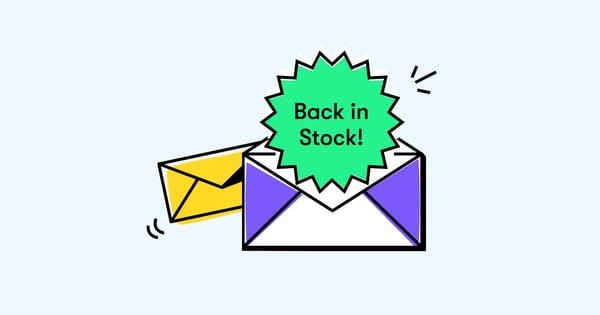Picture the scene:
You walk into a brick-and-mortar store. After a little browsing, you find the “I’m emo, but in a Gerard Way” T-shirt you’ve been searching high and low for.
But then disaster strikes—they don’t have your size.
Fortunately, the sales assistant is on hand to take your name and phone number. They’ll reach out when it’s back in stock.
Phew!
Of course, if the same scenario played out online, there’d be no store employee to help the customer out. More than likely, you’d lose the sale.
Unless you use back-in-stock notifications…
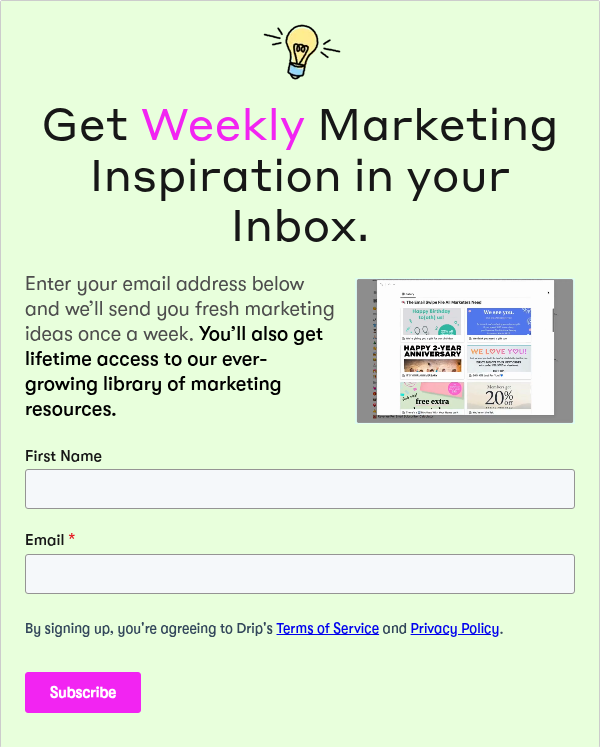
Back-in-stock notifications are a way to let customers know that an out-of-stock product they wanted to buy is available again.
The process generally works something like this:
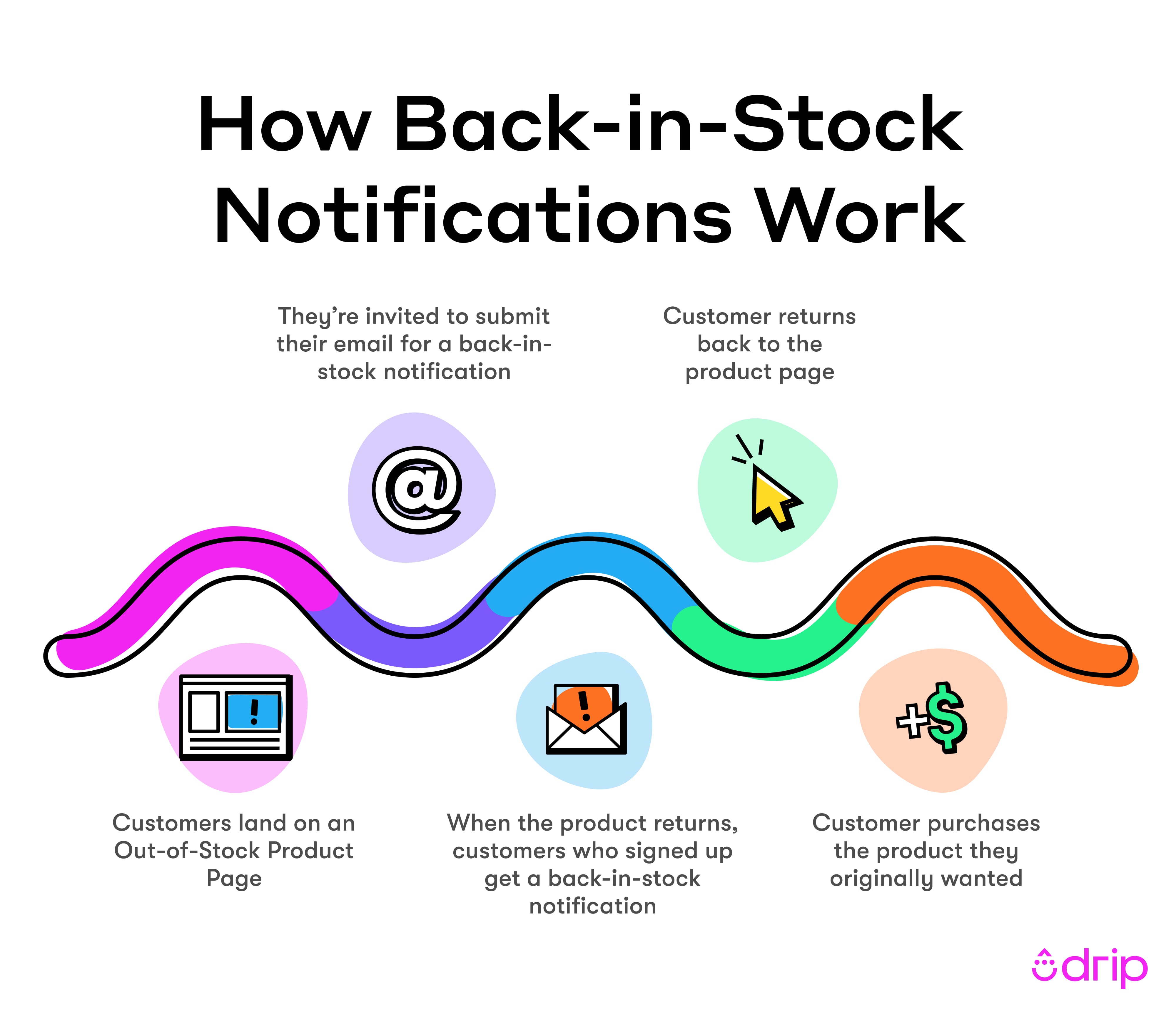
- Customers land on a sold-out product page.
- They’re invited to submit their email address to be notified when the product is back in stock.
- As soon as the product returns, customers who joined the email list are sent an automated back-in-stock notification, typically including a link to the product page.
- Customers head back to the ecommerce store to complete the transaction.
But does this simple process really help retailers win back customers who’d otherwise have bought from a rival?
Why Do You Need Back-in-Stock Notifications?
Let’s look at the case for adding back-in-stock notification functionality to relevant product pages:
Fact is, stockouts are an all-too-common experience for customers, with 82 percent of people who shop mostly or exclusively online saying they’ve encountered out-of-stock products.
For most consumers, this is only a mild inconvenience. But for brands, it’s a major headache.
A study from Kantar and Profitero looked at the impact of low stock rates (defined as an in-stock rate of less than 30 percent) versus the average sales generated by retailers while maintaining in-stock levels of 90+ percent. It found that, on average, low in-stock rates result in a:
- 42 percent drop in online sales
- 26 percent decline in conversions
- 22 percent less traffic
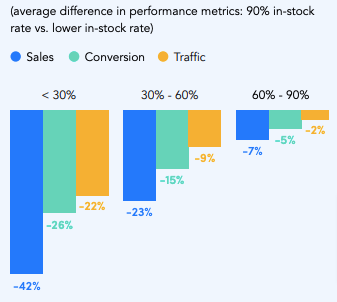 That sucks.
That sucks.
But back-in-stock notifications offer a glimmer of hope.
According to Barilliance, back-in-stock emails (or back-to-stock emails, as they’re referred to in this analysis) have the highest open rates of any email campaign type they analyzed, at 65.32 percent—almost 70 percent higher than the lowest-performing campaign type, post-purchase emails.
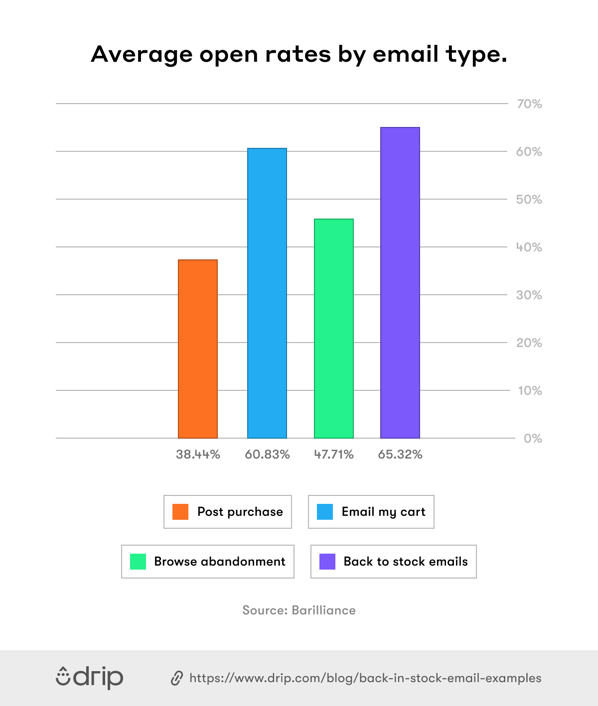
Not only that, but Barilliance also noted that back-to-stock emails have an average conversion rate of 14 percent, compared to an average of 8.17 percent for all email campaign types.
That’s almost twice as high by my math.
So when you send back-in-stock email notifications, there’s an extremely high chance they’ll be opened. And about one in seven people who open them will return to your online store to make a purchase.
All of which means you can recoup a bunch of sales lost to stockouts by nailing your back-in-stock notifications.
Follow these best practices to drive more conversions from your back-in-stock product pages…
Best Practices for Back-in-Stock Product Pages
The success of any back-in-stock notification campaign hinges on the effectiveness of the back-in-stock product page on which the customer originally landed.
1. Capture the Customer’s Email Address
First and foremost, your back-in-stock product page should offer the customer a way to sign up for email notifications when the product in question returns to stock.
In this example from Good as Gold, the regular “Add to Cart” CTA button has been replaced with an unclickable “Sold Out” message, beneath which is an option allowing customers to sign up for notifications:
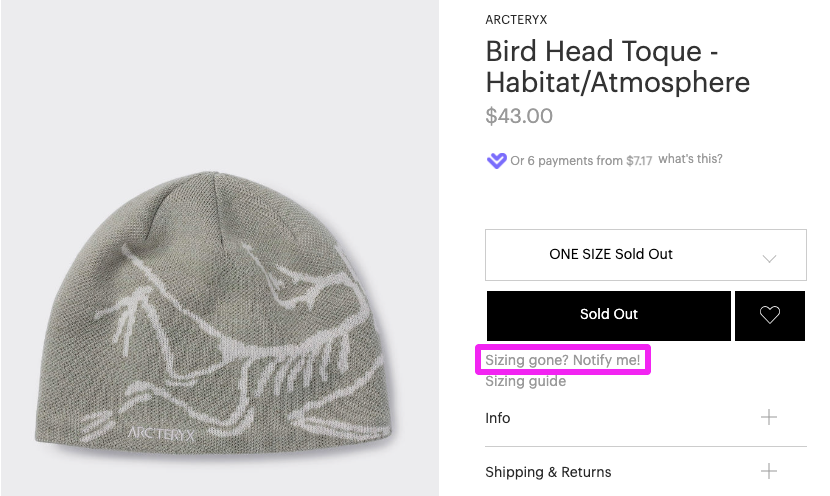 We’d prefer this option to be more prominent—ideally, it’d replace the CTA button.
We’d prefer this option to be more prominent—ideally, it’d replace the CTA button.
But at least it gives customers some way to find out when the object of their affections is back in stock.
2. Give Customers an Alternative
As well as capturing email addresses for your back-in-stock notification campaigns, it’s worth showing the customer a few alternative products.
That way, there’s a chance they’ll buy here and now, rather than in a few days (or weeks) when the original product returns to stock.
An old but extensive study published in the Harvard Business Review, based on data from more than 71,000 consumers in 29 countries, found that only one-quarter of customers who experience stockouts delay their purchase or cancel it altogether.
Instead:
- 31 percent buy the same item from a different retailer
- 26 percent buy a substitute from a different brand
- 19 percent buy a substitute from the same brand
What does this tell us?
The vast majority of customers are happy to buy a different product if their first choice is out of stock.
Streetwear brand Karmaloop is evidently aware of this. When you visit an back-in-stock product page on the retailer’s website, you’re transported to a boilerplate page prompting you to shop around for an alternative:
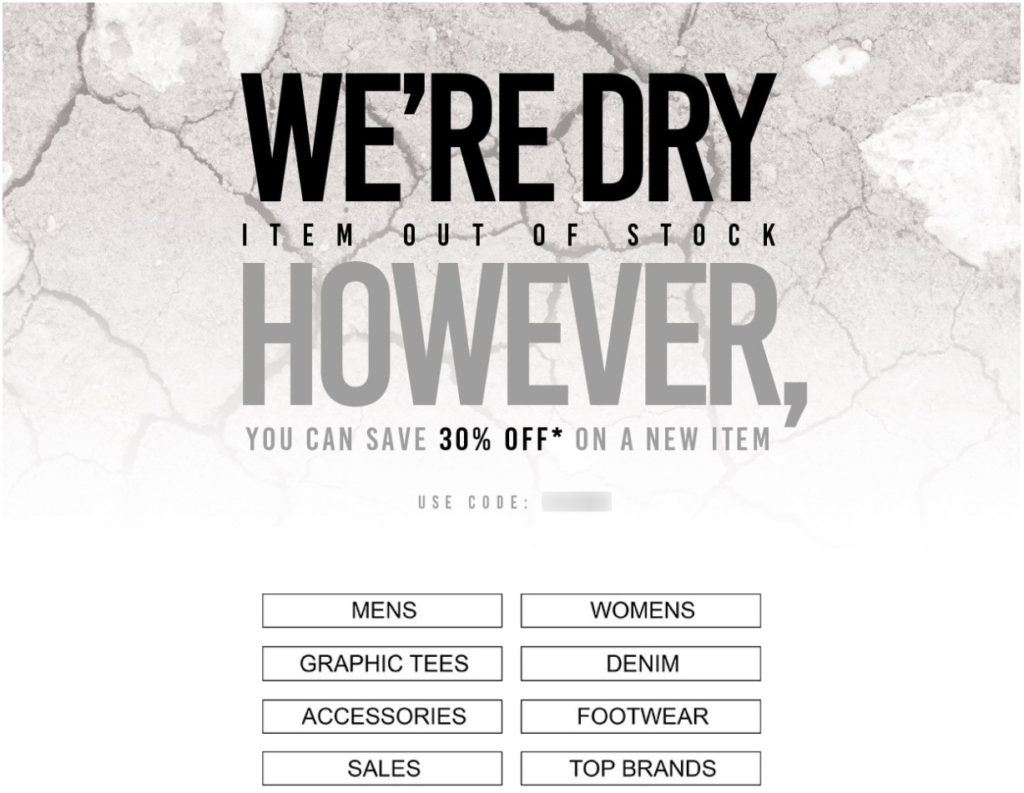
And, to ease the disappointment of your first choice being out of stock, Karmaloop offers you an enticing 30 percent discount.
Sure, it’s an aggressive offer, but it’s better than potentially losing the sale altogether.
3. Offer Pre-Orders On Replenished Stock
Pre-orders give customers the opportunity to purchase an back-in-stock—or yet-to-launch—product before it arrives.
Here’s an example of how this looks, courtesy of H-Street Skateboards:
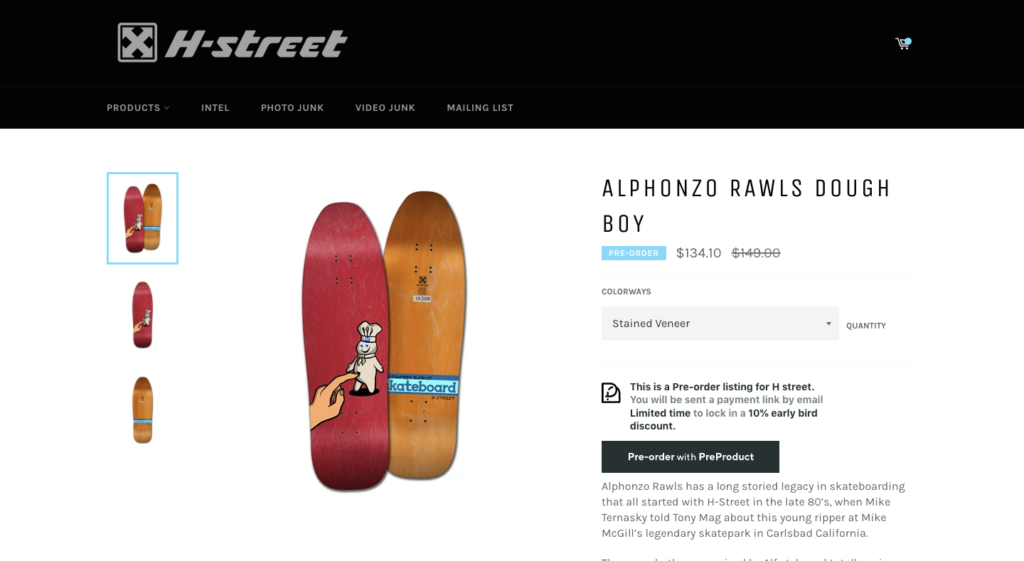 Not only do customers get to guarantee their purchase in advance, but they also receive an enticing 10 percent discount for pre-ordering.
Not only do customers get to guarantee their purchase in advance, but they also receive an enticing 10 percent discount for pre-ordering.
This strategy means stockouts no longer prevent you from generating sales right now.
For more ideas, check out our guide: How to Optimize Back-in-Stock Product Pages for Conversions!
11 Back-in-Stock Notification Email Examples
1. Anthropologie: Pair Your Back-in-Stock Email with Killer Copywriting
When it comes to design and copywriting, most back-in-stock emails lack creativity. Many of them carry the subject line—you guessed it—“Back in Stock.”
Although there’s nothing wrong with being straightforward in your subject lines, you need to think of all the similar emails your subscribers are getting every day. How does yours compare to others in their inboxes?
Anthropologie has the answer. Sent with the subject line “we call this feeling Déjà Oooh”, Anthropologie’s back-in-stock email looks like this:
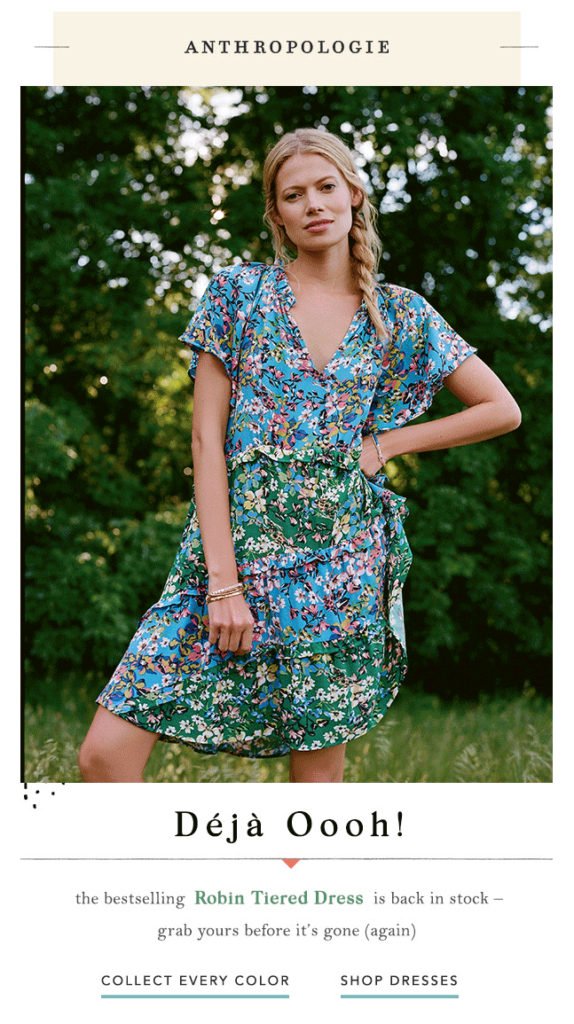
First of all, the wordplay in the subject line grabs your attention and makes you wonder what feeling they call “déjà oooh”.
In the email, the company focuses on a single product: its bestselling dress that’s now back in stock. The word bestselling adds even more social proof to this email. And the two call to action (CTA) buttons make it easy for you to click through and buy the product.
When you click to do so, Anthropologie cleverly displays how many people are viewing the product at the moment to increase urgency:
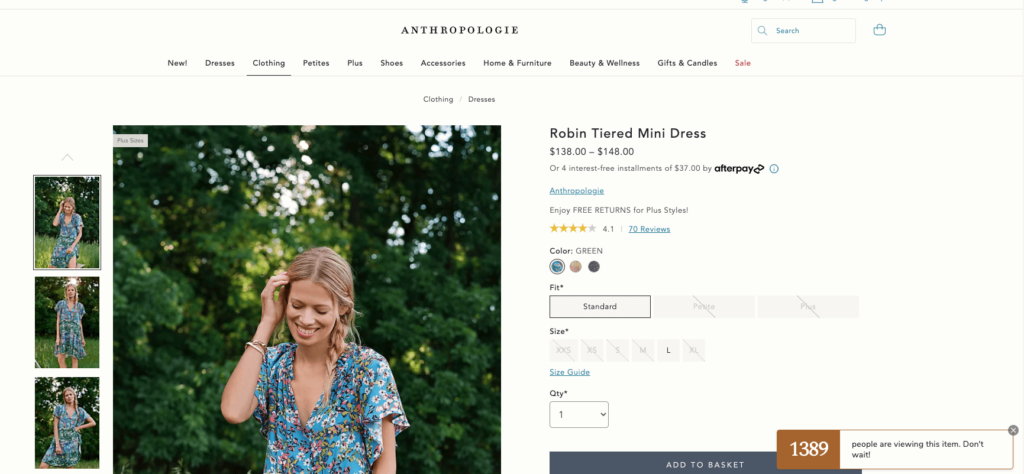
In the remainder of the email, Anthropologie recommends another product that goes well with the restocked dress:
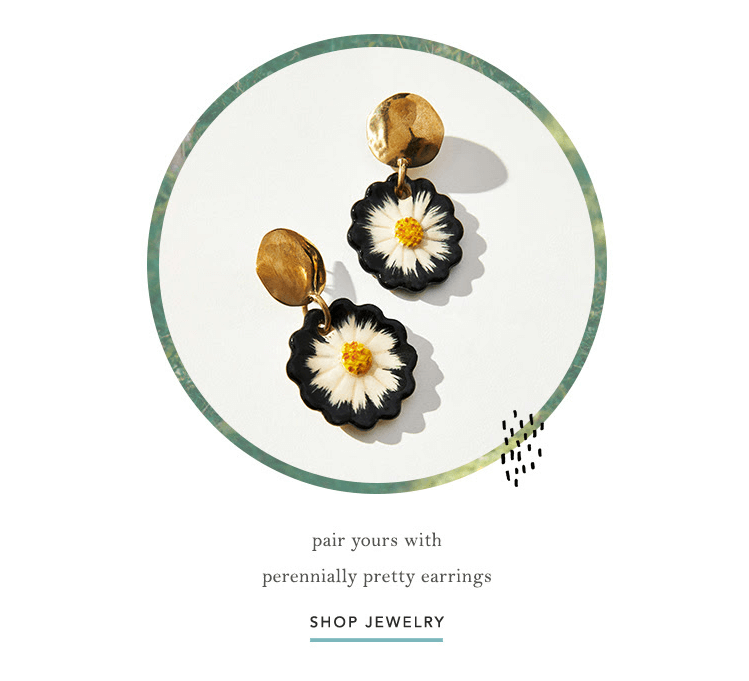
Notice how the company invites you to pair your dress with these earrings, assuming you’re going to buy the dress, rather than write unexciting copy like “frequently bought together”. This way, the company can sell more products to you in one order and increase its revenue.
All in all, Anthropologie’s back-in-stock email is a great example to follow if you have a single top-selling product you want to promote.
2. AYR: Use Actionable Language
Some words are naturally geared toward driving sales.
(Learn more about them in our roundup of persuasive words that sell.)
AYR understands this.
When I think of back-in-stock emails, AYR is one of the first brands that come to my mind.
It’s not only because AYR is a big fan of using scarcity in its email marketing, but also because they often send back-in-stock emails.
Its back-in-stock notification email features direct, actionable instructions commanding the customer to give the product a try (before it’s too late):
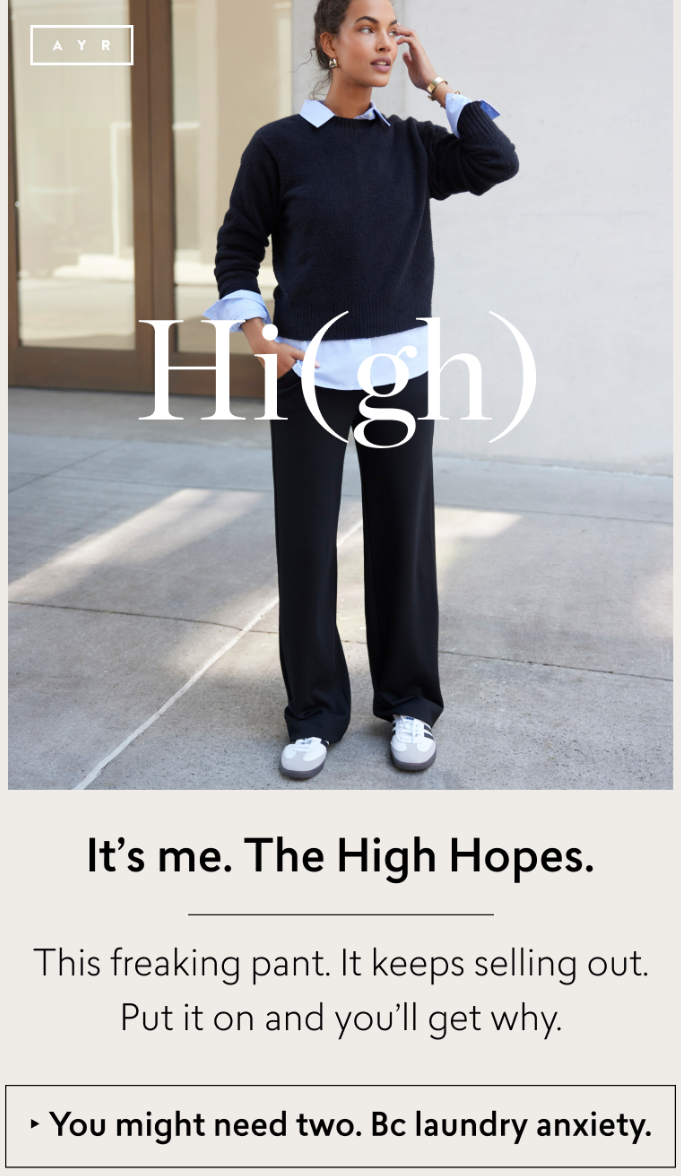 Interestingly, stockouts are essentially built into AYR’s business model.
Interestingly, stockouts are essentially built into AYR’s business model.
The brand manufactures products in small batches to ensure less waste, which means its category pages are dotted with references to items that are on the cusp of selling out:
 While this doubtless causes them a few headaches, it’s fantastic from a marketing perspective, because every AYR product could sell out.
While this doubtless causes them a few headaches, it’s fantastic from a marketing perspective, because every AYR product could sell out.
AYR’s example is ideal to follow if you’re producing in small batches or selling handmade or limited edition products. Be honest in your emails and explain what people should expect from your store.
3. Frank And Oak: Offer an Added Incentive
It’s one thing to have your favorite product return to shelves, and another thing when it comes back with a discount.
Frank And Oak doubles the excitement in this back-in-stock email where they announce a customer favorite is back, and it’s on sale.
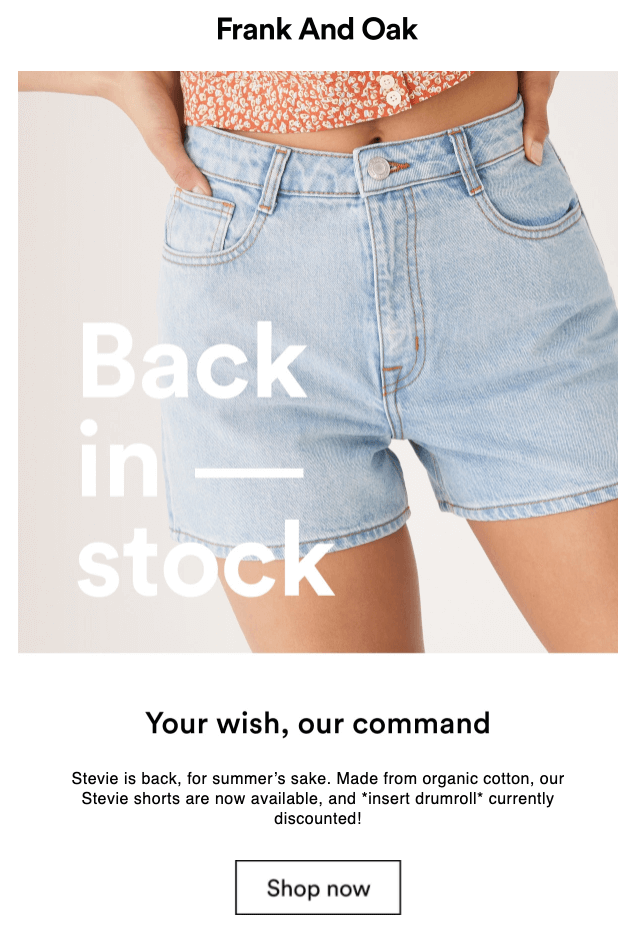
All the more reasons to purchase the company’s bestselling shorts.
If you’re not convinced yet, you can read the short, compact product description in the remainder of the email and learn that the product comes in two colors and at a discounted price:
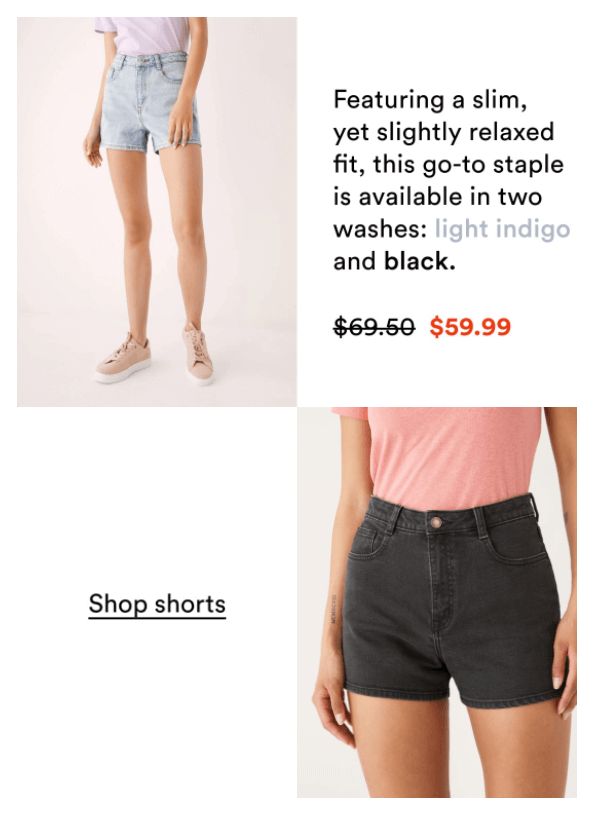
Frank And Oak doesn’t stop here. Next, the company recommends a top you can pair your shorts with, and it comes in different colors too:
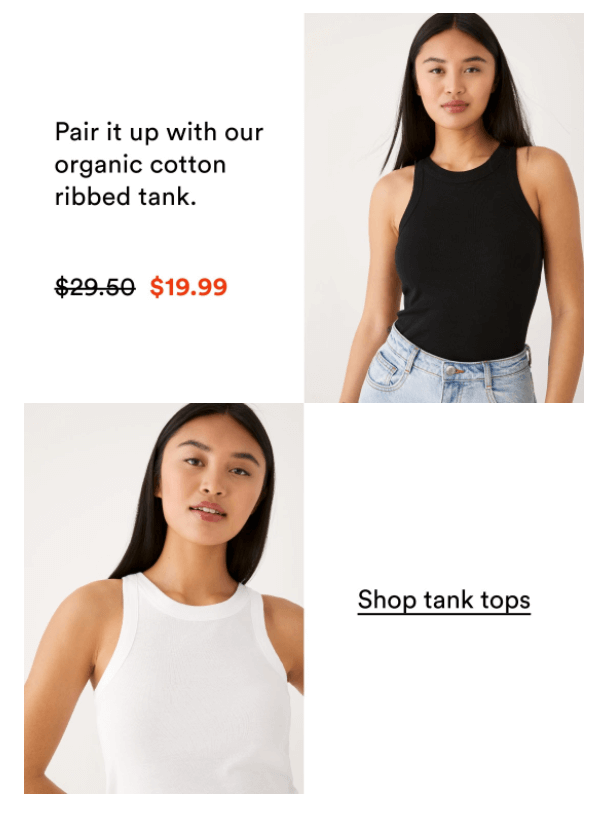
In this part of the email, Frank And Oak gives you ideas for how to wear your (future) new shorts while subtly cross-selling at the same time.
Even if you’re promoting a single item in your back-to-stock emails, you can still sell other products, as you’ve seen in this example. Follow Frank And Oak’s path to make relevant product recommendations in your back-in-stock emails without sounding too salesy.
4. Lunya: Leverage Scarcity and Urgency
One of the reasons back-in-stock campaigns are so effective is because they have baked-in scarcity and urgency. The customer knows this product is hard to get hold of—after all, they’ve tried to buy it before and been unsuccessful.
So it makes sense to build a sense of scarcity and urgency into your back-in-stock emails, just like Lunya does in this example:
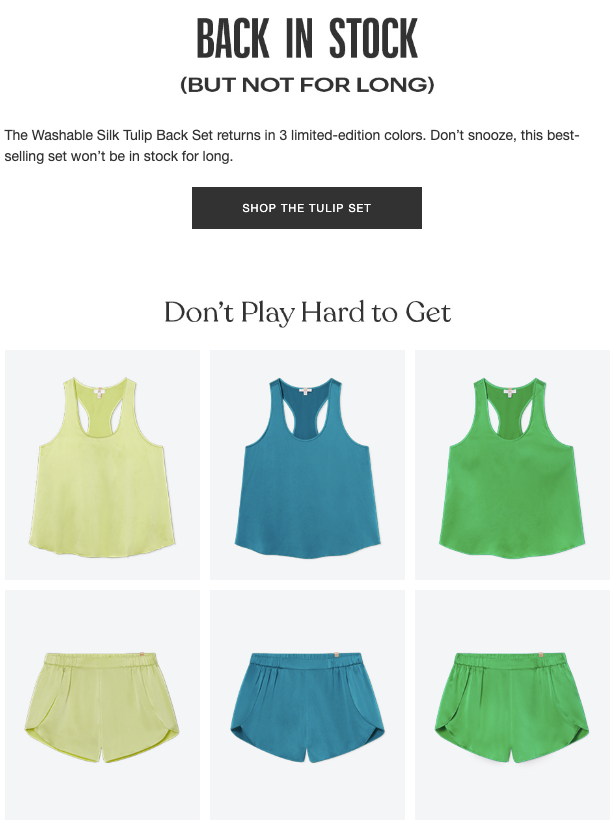 The message here is clear: if you don’t act now, there’s a good chance you’ll be disappointed again.
The message here is clear: if you don’t act now, there’s a good chance you’ll be disappointed again.
With this approach, there’s no need to offer the customer free shipping or a 10 percent discount to complete their purchase—the prospect of missing out is all the incentive they need.
5. Tarte: Provide Social Proof
Cross-selling is only one way to enhance your back-in-stock emails.
Tarte, on the other hand, has a whole other approach to this type of email.
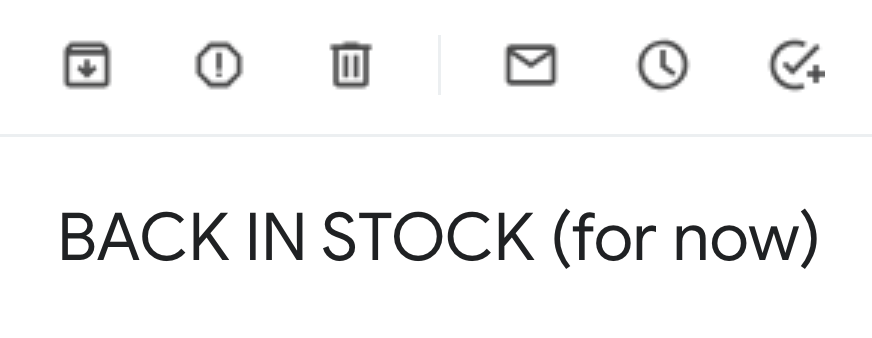
Its all-caps subject line with the sidenote “for now” hints at scarcity and it almost reads as a limited-edition restock.
In the email, the company brilliantly uses a GIF showing the product in context, instead of a simple image:
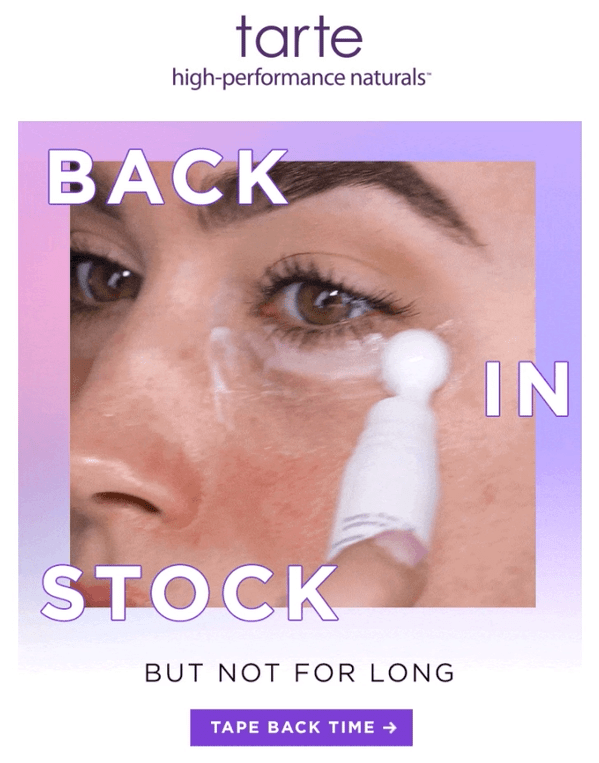
This helps Tarte’s subscribers visualize the product that once sold out. It also acts as a reminder of what it exactly is and what it does.
To highlight scarcity once more, Tarte says that the item is back in stock—but not for long.
What’s better, the CTA button “Tape Back Time” underlines the benefit of using the product rather than ask you to shop.
In the rest of the email, Tarte features a customer review, together with a claim to the product’s effectiveness:
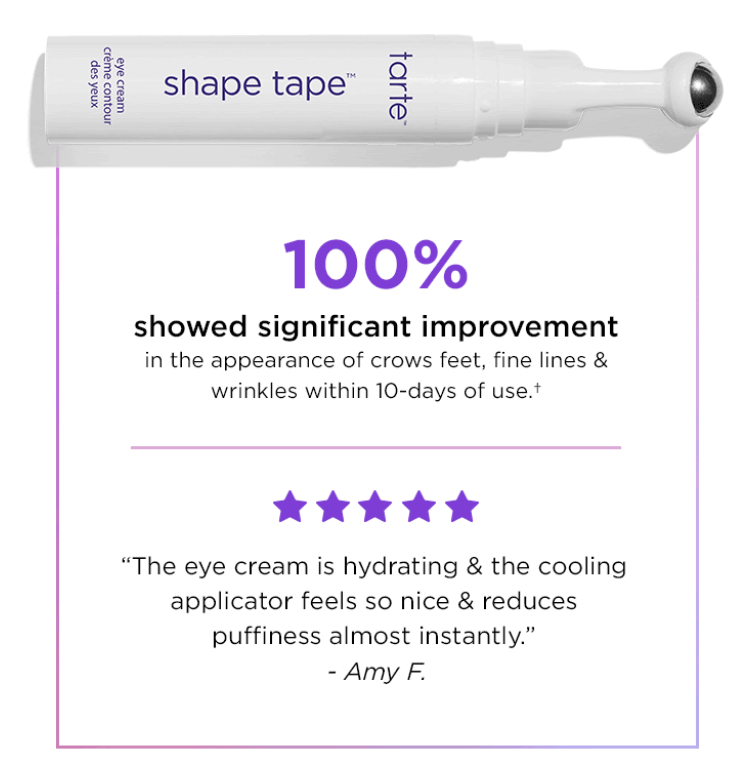
The testimonial and the clinical study add further persuasiveness and social proof to Tarte’s email. And it certainly isn’t a tactic used by most ecommerce brands.
The bottom line: remind subscribers of the capabilities and benefits of using the restocked product, and support it with a review when possible.
6. Rifle Paper Co: Offer a Discount on Back-in-Stock Products
Just because a customer signed up for back-in-stock notifications, there’s no guarantee they’ll come back and buy once stock levels return to normal.
Remember the Barilliance study I quoted earlier? It found back-to-stock emails have an average 14 percent conversion rate. Which is superb by the standard of most email campaign types, but it still means the overwhelming majority of recipients won’t buy.
So why not try giving them a gentle nudge?
Rifle Paper Co does this by offering a generous 25 percent discount on products that have just returned to stock:
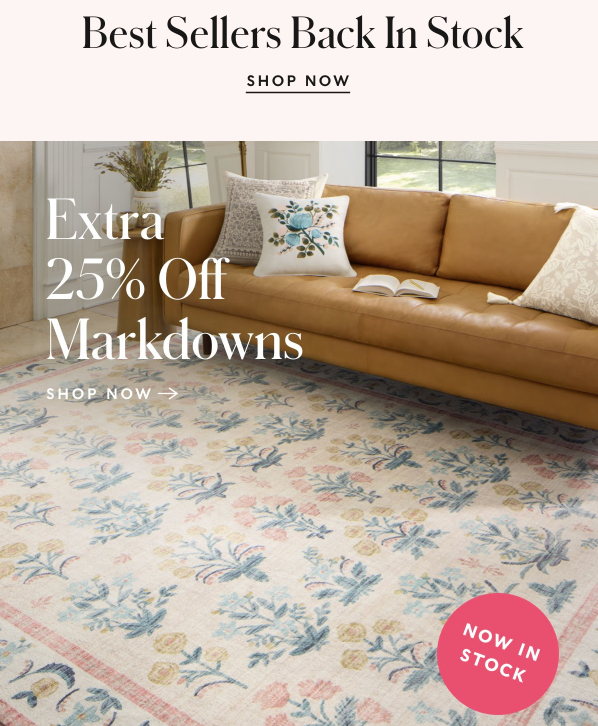 Of course, you don’t necessarily need to offer such an attractive incentive.
Of course, you don’t necessarily need to offer such an attractive incentive.
Experiment with different discount amounts and other promotions—like free shipping or a free gift with purchase—to find the sweet spot between driving sales and maintaining your margins.
7. Violet Grey: Bundle Hot Selling Items into One Back-in-Stock Email
All the examples I’ve featured so far promoted an item that returned to the shelves, be it a popular dress or a bestselling eye cream.
While that works well for large ecommerce companies with multiple product categories or single-product brands, it’s not the only way to go in your back-in-stock emails.
Take inspiration from Violet Grey, a brand that specializes in high-end makeup and skincare:
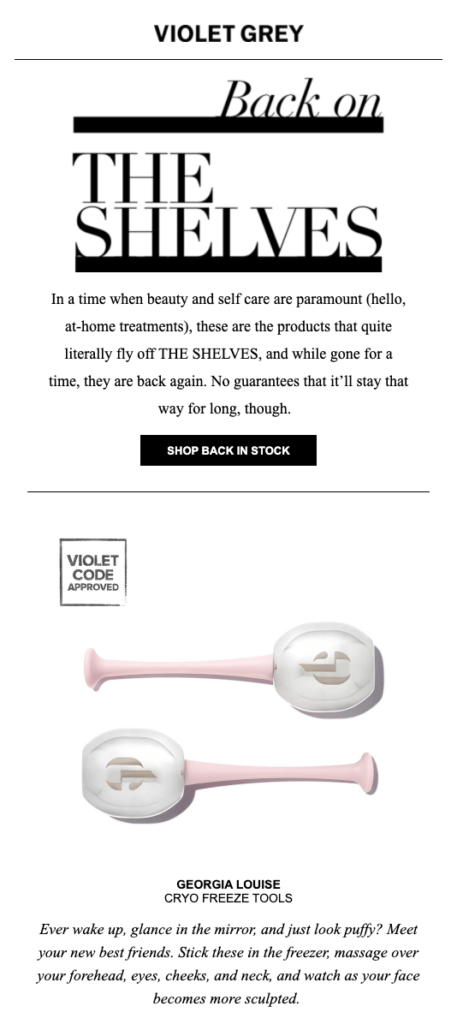
Sent with the subject line “Try Again?”, in this email, Violet Grey puts together all its back-in-stock items, rather than highlighting one product or category.
In the remainder of the email, they also feature a few restocked products with images and descriptions.
But what I like the most about this email is its short and crisp body copy.
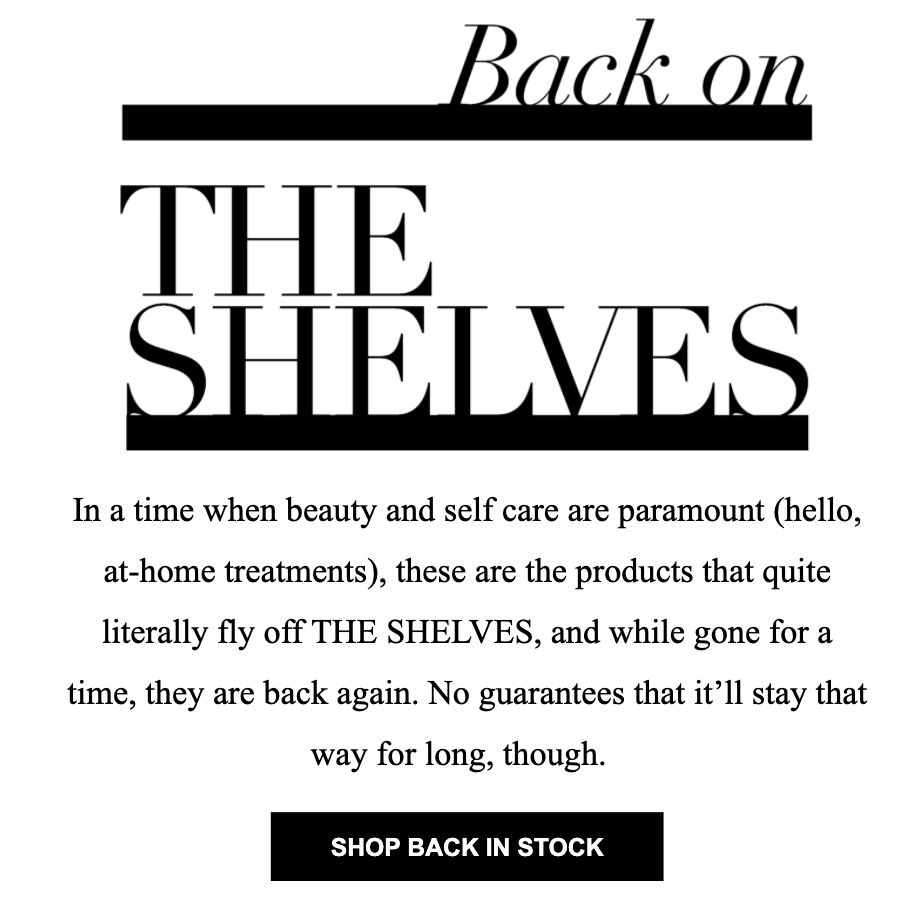
Similar to AYR, Violet Grey, first, explains why these products often “fly off the shelves”. As people spend more time at home due to the pandemic, at-home treatments are becoming more popular and causing Violet Grey’s products to sell out.
Notice how the company adds that there are “no guarantees” they’ll stay in stock for a long time. You better hurry and click that CTA button.
And when you do that, Violet Grey takes you to a dedicated landing page with all its back-in-stock items:
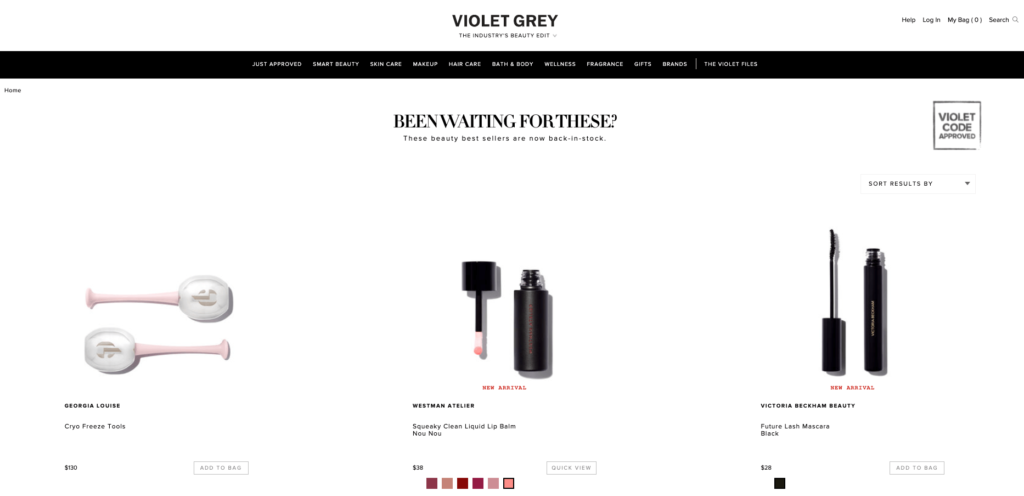
Whether you’ve really “been waiting for these” or not, Violet Grey cleverly takes you to this page with its popular products and aims to turn you into a customer.
Replicate Violet Grey’s email strategy if you typically restock multiple items from the same category or brand.
8. Buffy: Add a Cross-Sell to Back-in-Stock Notifications
Obviously, the main reason for sending back-in-stock emails is to encourage customers to come back and buy the product they originally wanted.
But why stop there?
In our next example, Buffy demonstrates how to combine an back-in-stock notification with a compelling cross-sell offer:
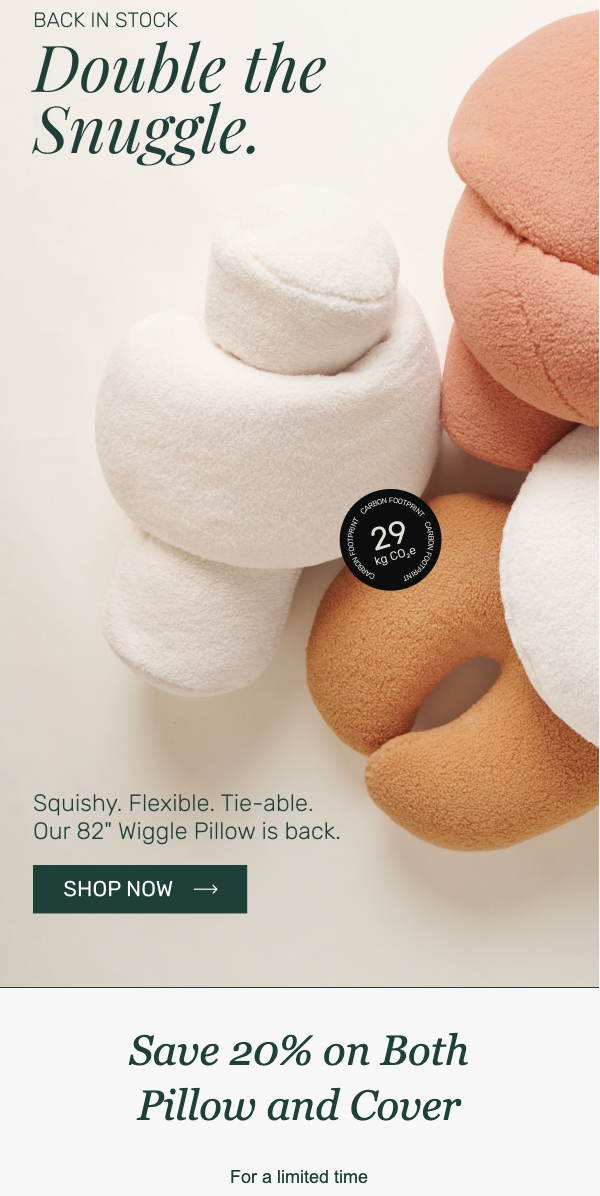 It’s a simple yet smart move, given that shoppers who are looking to buy a pillow are probably also interested in pillow covers.
It’s a simple yet smart move, given that shoppers who are looking to buy a pillow are probably also interested in pillow covers.
This same approach can work in pretty much any niche. Sell sneakers? Try cross-selling socks or cleaning products. Bundle a phone case with a portable powerpack. Try pairing makeup with accessories like brushes, bags, and cases.
The possibilities are endless!
9. Beauty Bay: Get All Your Back-in-Stock Products on Display
As I mentioned in the beginning, back-in-stock emails typically enjoy high open rates, but that doesn’t always translate to high clicks and orders.
A clean email design, a compelling CTA, and persuasive copywriting can help you achieve just that—and Beauty Bay knows this well.
I recently got this back-in-stock email from the company with the subject line “Look who’s FINALLY 🔙”:
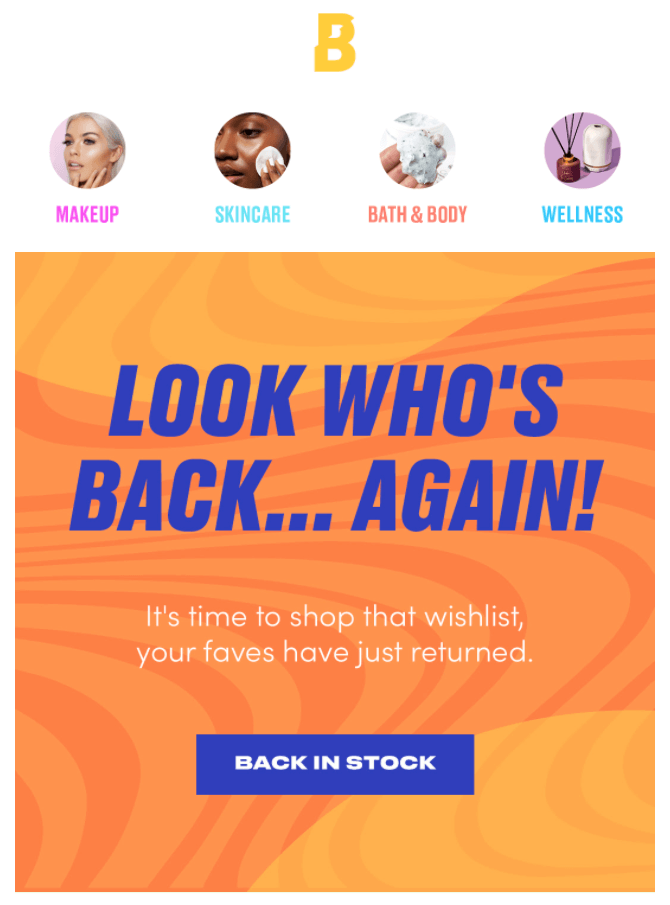
Its appealing color scheme, lighthearted copy, and the tempting CTA “shop that wishlist” make you want to read the rest of the email. And that’s where things get interesting.
Similar to the previous example, Beauty Bay curates all its restocked items in one email—with a twist:
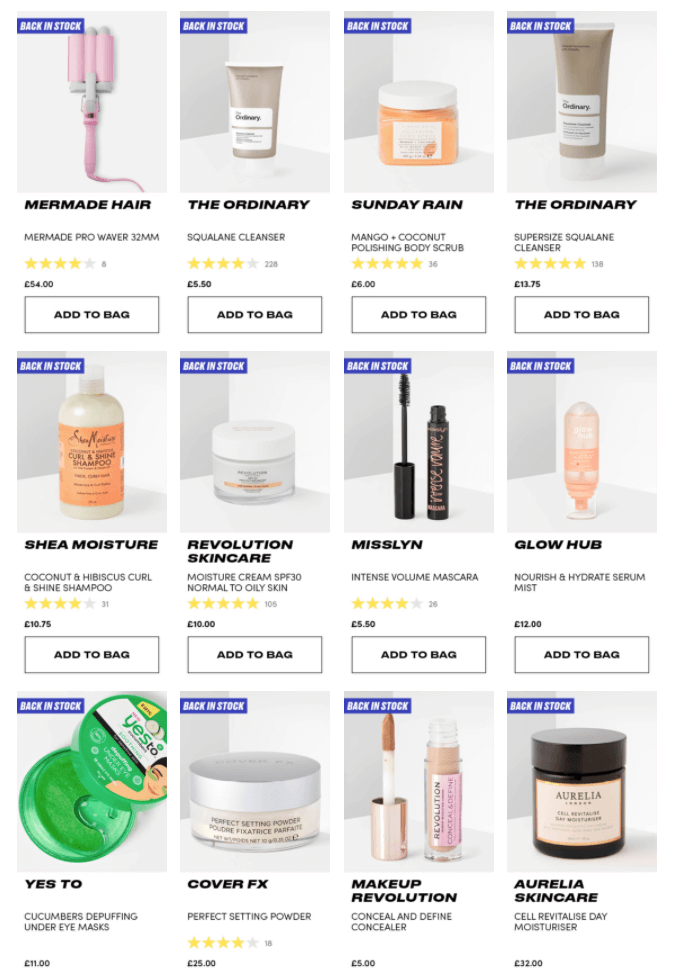
Beauty Bay doesn’t just throw in a few popular products; they design the entire email to look like a product listing page. You can see all the restocked products and their price and rating information in the email, without clicking the CTA or jumping to a landing page.
If something catches your eye, you can simply click through the email and buy the product. It’s a brilliant way to reduce friction and increase conversions from your back-to-stock emails.
10. Public Rec: Share Features and Benefits
Hopefully, there’ll only be a day or two between the customer experiencing a stockout, signing up for notifications, and receiving an email telling them the item is back in stock.
But in the fast-moving world of online retail, a couple days might as well be a lifetime.
Think how many ecommerce ads and marketing emails the customer will have received since they encountered that back-in-stock product. Dozens? Hundreds?
So it’s worth reminding them what they loved about your product in the first place.
That’s precisely what Public Rec does in this example.
It starts off looking like a regular back-in-stock notification, with all the typical messaging about the product’s best-selling status…
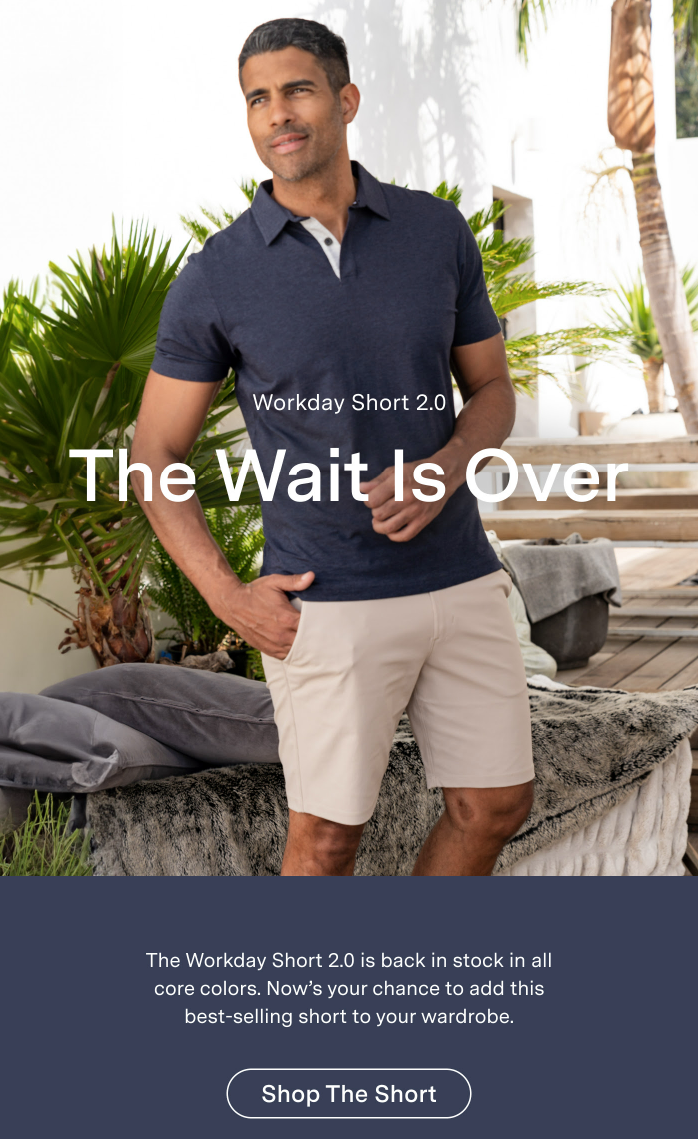 …but the email goes on to persuade the customer that the product is still right for them by highlighting some of its key features and benefits:
…but the email goes on to persuade the customer that the product is still right for them by highlighting some of its key features and benefits:
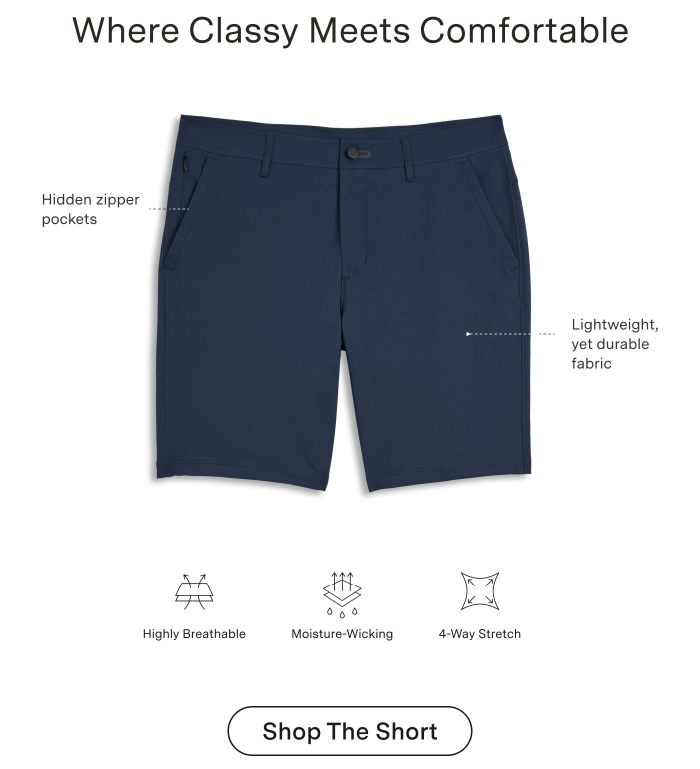 Who could resist a pair of shorts that stretch in four different ways?
Who could resist a pair of shorts that stretch in four different ways?
11. Apothékary: Be Bold
All the examples I’ve covered so far were safe picks.
They’re the best—but cautious—approaches to back-in-stock emails. They get the opens, clicks, and conversions on the spot.
But if you’re up to something bigger, like relaunching a limited edition collection as Apothékary does, you need to save this email in your swipe file.
Check out this short email the company recently sent:
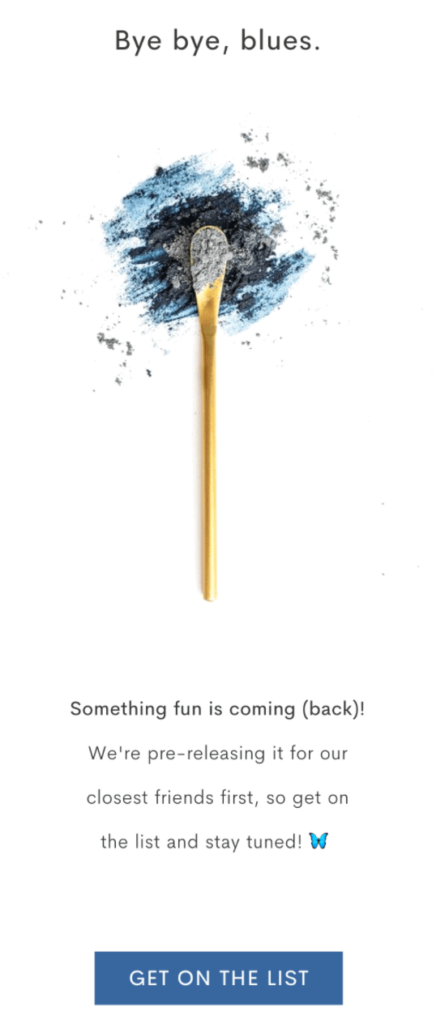
It’s a back-in-stock pre-launch email—something I’ve never seen before.
In the email, sent with the subject “We blue you away once. 🦋”, Apothékary teases the return of an old product in a mysterious way, which evokes curiosity.
The company also shows its appreciation to you for being on its list by calling you a “close friend” and promising an early product release.
With this email, Apothékary aims to get you to commit to its product launch. Because if you get on the list and make a commitment to yourself today, you’ll more likely want to stay consistent and buy the product when it launches.
It’s an outstanding example of Robert Cialdini’s “Commitment and Consistency” principle in action.
When Apothékary finally launches the product, you find out that it’s a formerly limited edition item—back by popular demand.

What Apothékary does is simply restocking an old product. But the way they announce that the item is back-in-stock is remarkable.
It’s an awe-inspiring example of not only back-in-stock emails, but also product launches and announcements.
How to Create Back-in-Stock Notification Emails for Shopify
Wouldn't it be nice if there was already a feature for Back-in-Stock emails already built into the tools you love?
It's your lucky day.
Drip Back-in-Stock includes “A product is back in stock” trigger template that’s connected to your Shopify store and tracks when out-of-stock products are back.
Plus, we even included an Onsite popup campaign that’s set up to populate on all pages where a product (or any of the product variants) are out of stock.
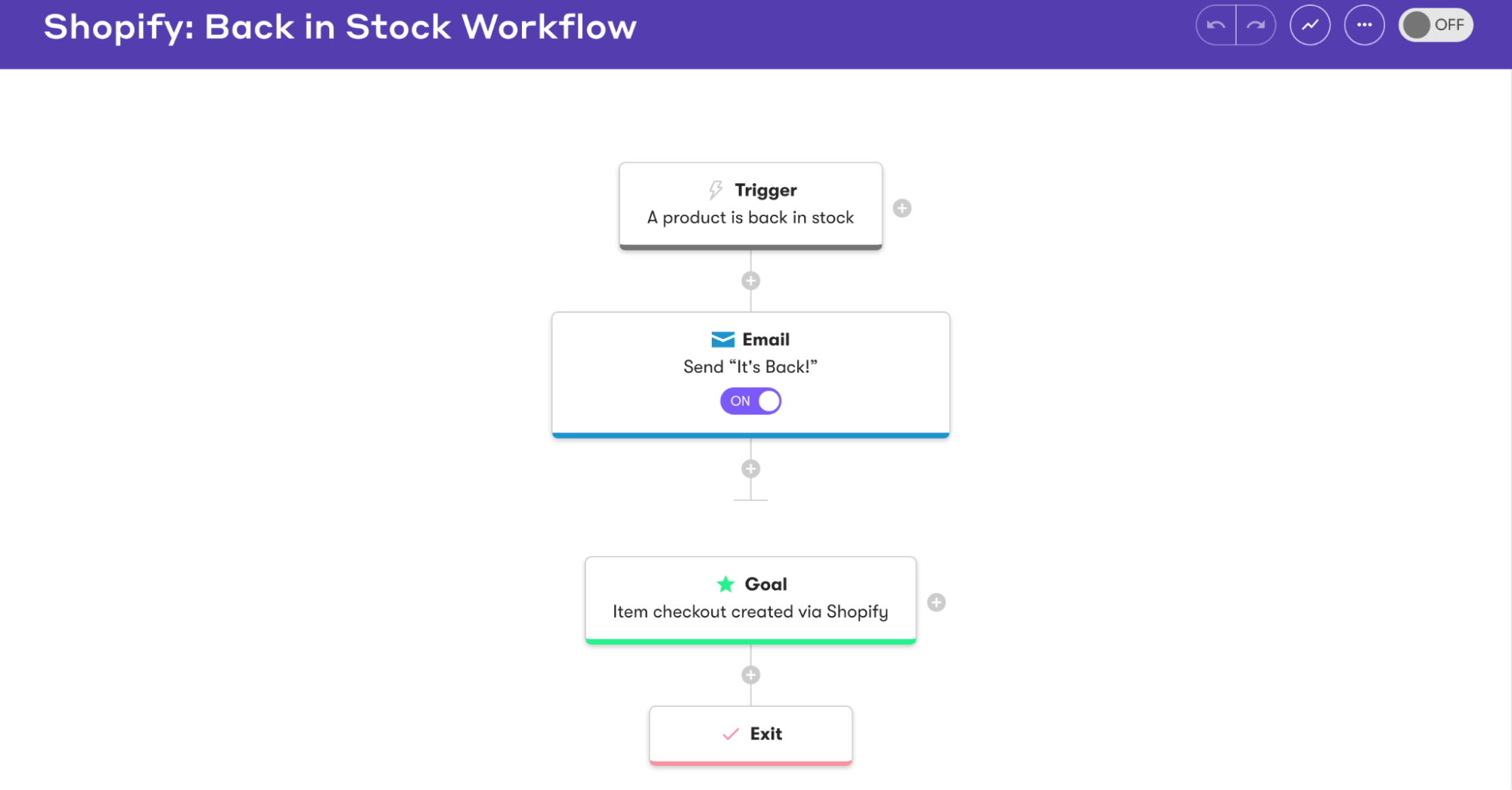 There are a lot of Back-in-Stock solutions for Shopify, but Drip’s solution takes it a step further. Unlike many restock solutions:
There are a lot of Back-in-Stock solutions for Shopify, but Drip’s solution takes it a step further. Unlike many restock solutions:
- You’re able to account for product variants: The black one sold out but you’ve got tons of the product in red? Or maybe one size in particular sold fast? People can opt-in to being notified about their specific variant.
- The set up is simple and quick on Shopify: You don’t need to make any changes to your code. As long as you have your Shopify store connected to Drip, it’s a matter of clicks.
- Save time and money: If you’re already using Drip for email and marketing automation, you eliminate yet another costly third-party tool.
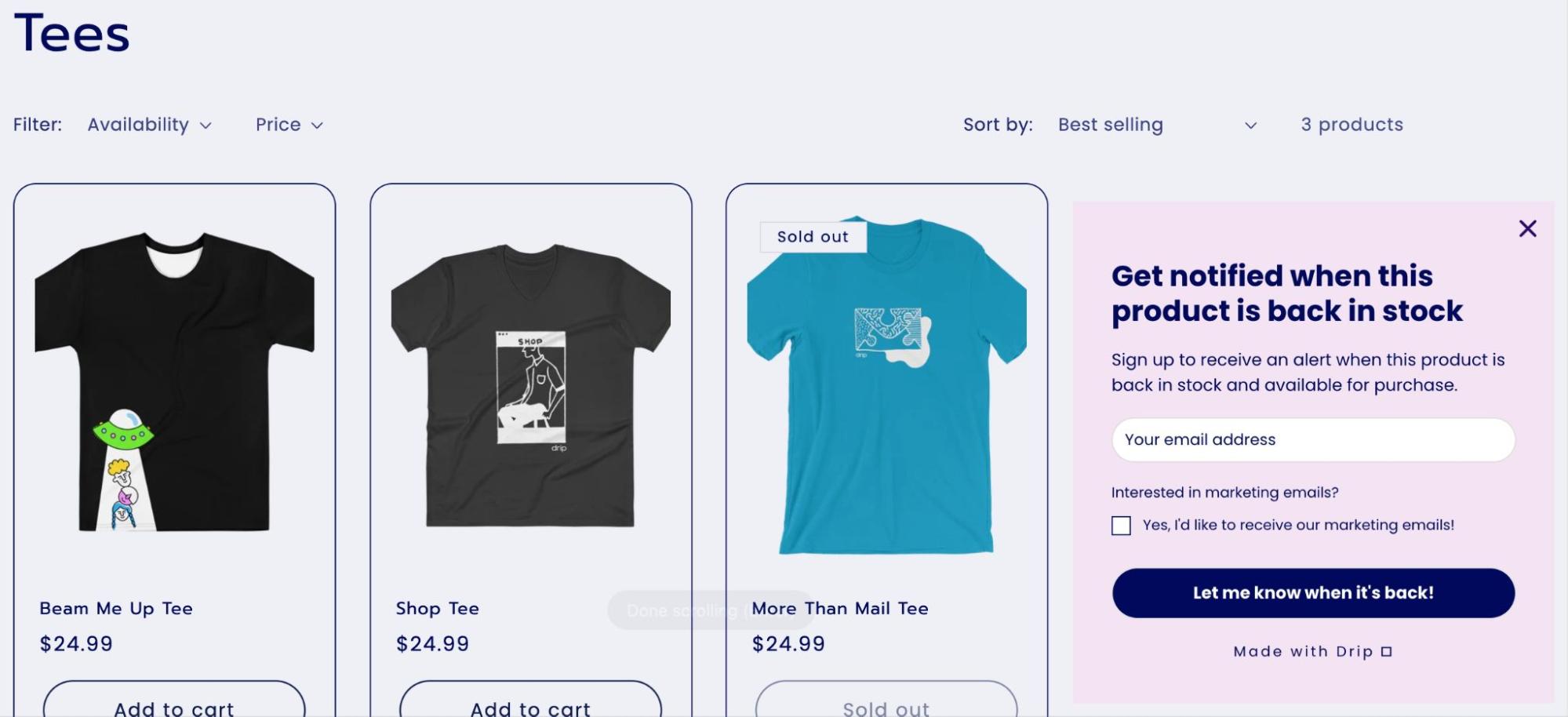 Not to mention, when customers sign up for back-in-stock alerts, they’re manifesting strong intent to purchase.
Not to mention, when customers sign up for back-in-stock alerts, they’re manifesting strong intent to purchase.
Try offering them the opportunity to opt-in to your normal marketing emails.
Chances are, if they liked one of your products, they’re likely to enjoy others too.
What a great way to begin building that relationship with your customers!
Steal this Back-in-Stock Notification Template
We’ve shown you some of our favorite back-in-stock notification emails.
But if you still need a little inspiration, feel free to copy, paste, and tweak this back-in-stock notice template:
Subject: {Product Name} is back in stock!
Hi {first name},
We’re delighted to report that a product you wanted to buy, {product name} is now back in stock.
{Product Image}
We’d hate you to miss out again, so snap it up while you can—and we’ll even throw in free shipping for your trouble!
{Shop now CTA button}
You’re welcome!

Send High-Converting Automated Emails With Drip
Nowadays, any old marketing platform can send automated emails. But few make it quick and easy to build automated email campaigns triggered by specific customer behaviors.
Drip is different.
With our intuitive visual workflow builder and our library of 20+ proven-to-perform workflow templates, our users can create automated campaigns based on how customers interact with your ecommerce store.
That means your automated emails feel hyper-personalized and arrive at exactly the right time, leading to more opens, click-throughs, and conversions.
Of course, we don’t expect you to take our word for it.
Find out for yourself by signing up for your 14-day free trial!

